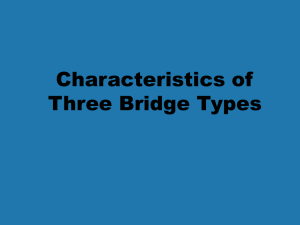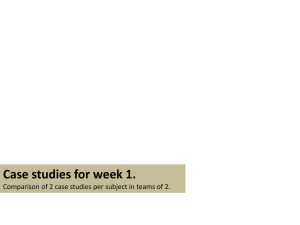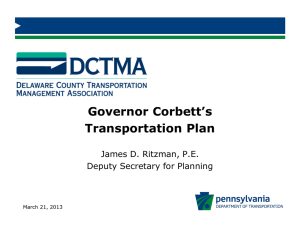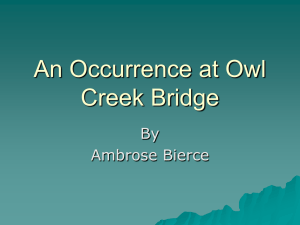BRIDGES & Structural Failure – Grade 8 CAPS
advertisement
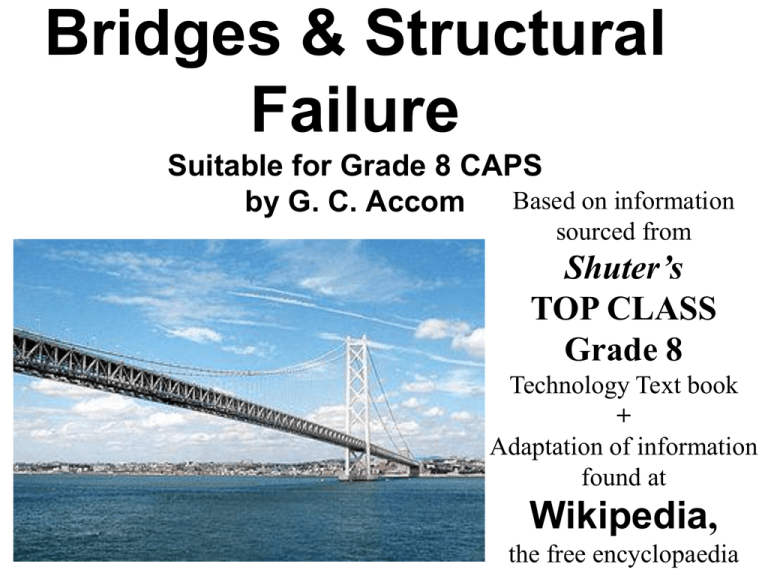
Bridges & Structural Failure Suitable for Grade 8 CAPS Based on information by G. C. Accom sourced from Shuter’s TOP CLASS Grade 8 Technology Text book + Adaptation of information found at Wikipedia, the free encyclopaedia DEFINITION A bridge is a structure built to span physical obstacles such as a body of water, valley or road for the purpose of providing passage over the obstacle. Designs of bridges vary depending on the function of the bridge, the nature of the terrain where the bridge is constructed, the material used to make it and the funds available to build it. WHERE DID THIS IDEA COME FROM? The first bridges were made by nature itself — as simple as a log fallen across a stream or stones in the river. The first bridges made by humans were probably spans of cut wooden logs or planks and eventually stones, using a simple support and crossbeam arrangement. Some early Americans used trees or bamboo poles to cross small caverns or wells to get from one place to another. A common form of lashing sticks, logs, and deciduous branches together involved the use of long reeds or other harvested fibers woven together to form a connective rope which was capable of binding and holding in place materials used in early bridges. Primitive suspension bridge over the River Astore Types of bridges • BEAM & COLUMN BRIDGES •SUSPENSION BRIDGES •CABLE – STAYED BRIDGES •ARCH BRIDGES •CANTILEVER BRIDGES BEAM and COLUMN BRIDGES 1. The beam and column bridge is the simplest type of bridge 2. It is usually straight. 3. The beam is supported at each end by columns. 4. Columns are designed to hold the weight of a structure and in this case , a beam bridge. See pages 16 & 17 of Shuter’s TOP CLASS Technology textbook Grade 8 ABUTMENT L O A D A beam bridge consists of a rigid horizontal member called a beam that is supported at both ends, either by a natural land structure, such as the banks of a river, or by vertical posts called columns. COMP There are many forces that act on a beam and column bridge. R The bridge's own weight can put a huge strain on the structure. E For the beam and column bridge to be strong, it must develop S compression along the top and tension along the bottom. S I O N TENSION Sky_gate_bridge Multispan plate girder bridge deck on concrete piers. Advantages of beam and column bridges The beam bridge rests on simple columns. A beam may be built away from the final position, and lifted swiftly into place with no disruption to the traffic below. Disadvantages of beam and column bridges The beam bridge experiences large forces and therefore has to be very big in size. Suspension bridges In a suspension bridge the deck or road is suspended or hangs from the main cable in the bridge. The columns hold the main cable up. The anchorages pull the cable outwards and downwards. The hangers connect the deck to the main cable. The main cables are fixed to the towers at saddles to avoid sliding The deck carries the traffic. See pages 17 & 18 of Shuter’s TOP CLASS Technology textbook Grade 8 ADVANTAGES OF SUSPENSION BRIDGES 1. Suspension bridges can span very long gaps. The design allows the bridge to be made up of very long sections. 2. If one of the hangers fails or breaks, it can be replaced without disruption to the flow of traffic and will not have an effect on the stability of the bridge. 3. Suspension bridges do not have to be built along straight channels but can be designed along curves and arched spaces 4. Suspension bridges can be built with double decks for cars and trains. The strength of the cabling system is sufficient to hold the double decks DISADVANTAGES OF SUSPENSION BRIDGES 1. Suspension bridges are very expensive to build 2. They take a very long time to build. It can take up to nine months to connect the main cables to the anchorages. 3. The concrete towers has to be built in shallow bedrock. 4. The incomplete decks can be affected by strong winds Suspension.bridge.bristol. Golden Gate Bridge The cables are in tension, and the deck is in compression. The spans can be constructed as cantilevers until they are joined at the centre. A cantilever is a structure that is supported at one end only, while the other end projects out into space. The cables are made of high tensile steel. The columns are often made out of concrete. See pages 18 & 19 of Shuter’s TOP CLASS Technology textbook Grade 8 Advantages of cable-stayed bridges The two halves may be cantilevered out from each side. There is no need for anchorages. They can be cheaper than suspension bridges. Disadvantages of cable-stayed bridges In the longer sizes, the cantilevered halves can be affected by strong winds during construction. The cables require careful treatment to protect them from corrosion. Cable-Bridge_over_Krishnarajapuram_Railway_station. Rama_VIII_Bridge_at_night. Arches An arch is a curved structure across an opening. An arch not only spans a gap or space but it also supports a load. An arch is totally in compression. Arches in buildings Arches in buildings were used often in ancient times. The Romans used arches to build aqueducts. Arches are also used in houses, halls and theatres for decoration. The arch designs bring more air and light to these venues. See pages 18 & 19 of Shuter’s TOP CLASS Technology textbook Grade 8 Arch bridges An arch bridge is a complicated structure which should be purely in compression and should not bend. It is often made from materials such as masonry (stone), cast iron and concrete. The two most important components of an arch bridge are the keystone and abutment. The keystone is the main piece of the arch bridge and is assembled last. lt holds the whole bridge together. The abutment is the contact point of the arch and river bank. See pages 21of Shuter’s TOP CLASS Technology textbook Grade 8 Advantages of arches The entire arch is in compression. Arch bridges can be very long because there is no tension in the bridge. Disadvantages of arches An arch cannot stand until it is complete. The two halves must be cantilevered using cables. So, a cable-stayed structure must be built to hold both ends of the arch before it is joined. This is building two structures. Mehmed Paša Sokolović Bridge inVišegrad Bosnia and Herzegovina Stone arch bridge in Shaharah, Yemen Arches in dam walls An arch dam has a dam wall that is curved and made from concrete. The dam wall curves upstream towards the flow of water. As the water presses against the arch in the dam wall the compression is spread to the ends of the dam wall and strengthens it. Cantilevers A cantilever is a structure that is supported at one end only, while the other end projects out into space. See pages 23&24 of Shuter’s TOP CLASS Technology textbook Grade 8 Cantilever bridges In the arch and beam we saw that the bridges were supported at two places, that is at both ends. A cantilever differs from the arch and the beam in that the attachment points are not at opposite ends. The cantilever projects out into space and the support is at one end only. Most cantilever bridges have two cantilevers, with a beam suspended between their free ends. You have already learnt about cable-stayed cantilever bridges on pages 18-19. The Pierre Pflimlin bridge is a balanced cantilever made of concrete, shown here under construction.jpg Advantages of cantilever bridges Building out from each end enables construction to be done with little disruption to traffic below. The span can be greater than that of a simple beam, because a beam can be added to the cantilever arms The supports can be simple columns. Disadvantages of cantilever bridges Like beams, they maintain their opposition of large tensile and compressive forces, as well as shear, and therefore are very large and heavy Structural failure Structural failure is the inability of a structure or structural member to perform its intended function. It is caused by collapse or excessive deformation. The three most likely ways structures fail are: fracture of a member, bending and toppling over. Fracture Fractures often occur due to a lack of strength in the structure. When designing a structure the load that the structure must withstand needs to be considered. A structure cannot withstand forces continuously for extended periods of time. Most structures get brittle and lose their strength with time. This is a natural phenomenon. These structures either have to be replaced before they fail or need to be "patched up". Most structures are built with a life span. This means that we calculate how long a structure will last before it fails. This gives us plenty of time to either replace it or fix it. Bending Bending occurs due to the flexing and buckling of a structure due to a lack of stiffness. Sometimes structures are not made of the appropriate material, resulting in failure. Toppling over Toppling over occurs due to a lack of stability in the structure. The structure is either top heavy or has a base that is too narrow. Important considerations When building a bridge, a designer needs to calculate the following: The maximum amount of traffic the bridge can hold at one time. The weight of the traffic. Strength of winds that pass through the area . Weight of the bridge END OF SESSION
